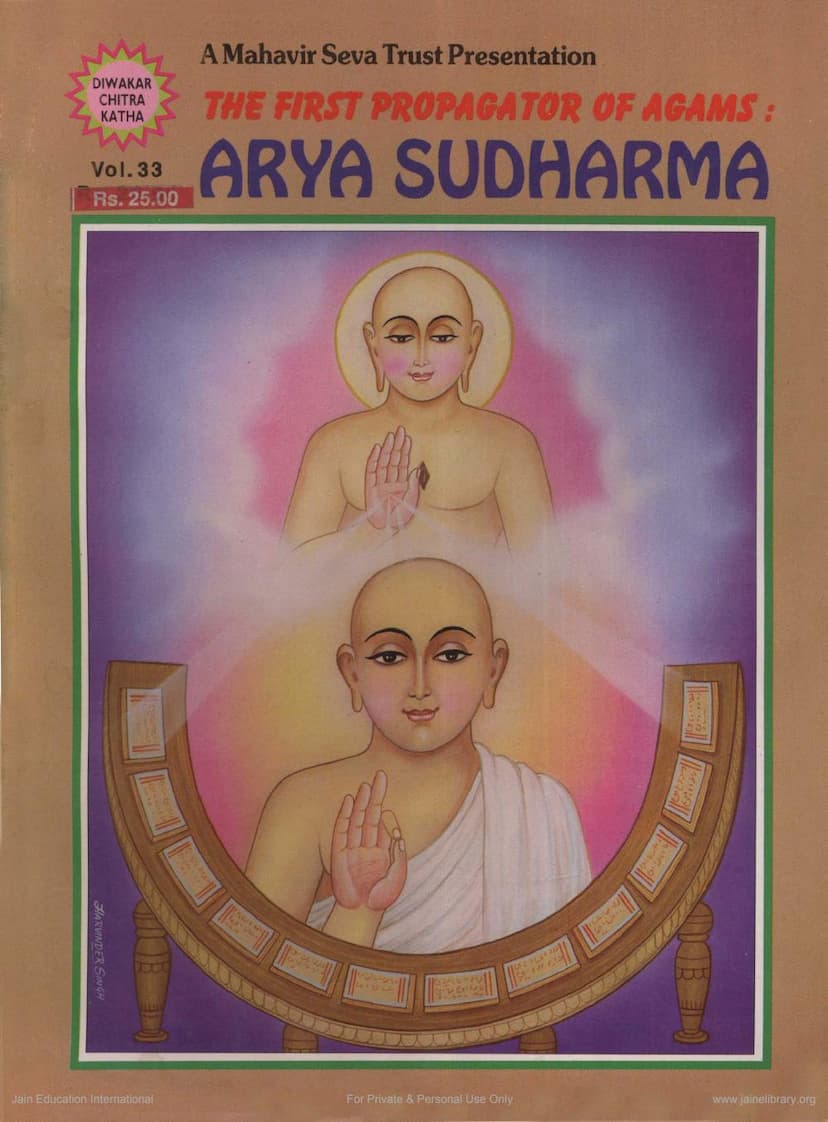Arya Sudharma Diwakar Chitrakatha 033
Added to library: September 1, 2025

Summary
This Jain text, "Arya Sudharma Diwakar Chitrakatha 033," published by Mahavir Seva Trust, Mumbai, is a biographical account of Arya Sudharma, the fifth Ganadhar (chief disciple) of Bhagavan Mahavir. The book, authored by Acharya Vijaya Nityanand Suri ji M. and compiled by Srichand Surana "Saras", Dr. Mansukhbhai Jain, and Sanjay Surana, with editing by Muni Shri Chidanand Vijaya ji M., highlights Arya Sudharma's significant role in the propagation and continuation of Jain teachings.
Key aspects covered in the book:
-
Arya Sudharma's Importance: He is recognized as the first Pattadhar (head of the order) of Bhagavan Mahavir's lineage and the first leader in the spiritual and disciple tradition. He is credited with giving scriptural form (Sutras) to Bhagavan Mahavir's teachings and transferring this knowledge to his chief disciple, Arya Jambu. All present-day Shramans and Shramanis of the Shvetambar Jain sects are considered disciples of Arya Sudharma.
-
Early Life and Education: Arya Sudharma was born to Dhammil and Bhaddila in the village of Kollag in the Videh state. His mother had a dream of Goddess Saraswati, foretelling his future as a bridge between Brahmin and Shraman traditions. He became a renowned scholar of the Vedas and fourteen subjects, establishing a large school with 500 students.
-
Encounter with Bhagavan Mahavir: Sudharma was invited to a grand Yajna (ritual sacrifice) in Pava, where he witnessed celestial vehicles heading towards Shraman Mahavir. Intrigued and driven by pride in his own scholarship, he went to confront Bhagavan Mahavir.
-
Acceptance of Jainism: Upon hearing Bhagavan Mahavir's discourse, particularly on the nature of reincarnation and karma, Sudharma realized his ignorance. He was profoundly impressed by Bhagavan Mahavir's divine radiance and accepted initiation, becoming a disciple. His 500 disciples also followed suit.
-
Leadership and Succession: After initiation, Bhagavan Mahavir entrusted Arya Sudharma with the administration of the Gana (ascetic organization). He played a crucial role in guiding the studies and conduct of the ascetics. Following the nirvana (liberation) of other Ganadhars, their disciples were directed to Arya Sudharma. Ancient writings confirm that Bhagavan Mahavir himself appointed Arya Sudharma as the head of the Gana, recognizing his abilities and long life expectancy. After Bhagavan Mahavir's nirvana, Arya Sudharma became the first Pattadhar, leading the Sangh.
-
Dissemination of Knowledge: The book details Arya Sudharma's role in propagating the Agams. He recited and compiled the Angas (canonical scriptures) of Bhagavan Mahavir to his chief disciple, Jambu Kumar. The text provides a summary of the content of the 12 Angas, including Acharanga, Sutrakritanga, Sthananga, Samvayanga, Vyakhyaprajnapti (Bhagavati Sutra), Jnatadharmakatha, Upasakadasha, Antakriddasha, Anuttaraupapatikadasha, Prashna Vyakarana, Vipakashrut, and Drishtivad. It highlights the importance of ethical conduct, philosophical discussions, practical examples, and the consequences of karma.
-
Key Disciples and Initiations: The book narrates significant events like the initiation of Prince Gopalak of Avanti and the profound renunciation of Jambu Kumar, the son of merchant Rishabhdatt. Jambu Kumar's conversion and subsequent initiation, along with his eight wives, his parents, and 500 thieves led by Prabhav, marked a significant mass initiation ceremony led by Arya Sudharma after Bhagavan Mahavir's nirvana.
-
Attainment of Keval-jnana and Nirvana: After propagating Jainism for 12 years, Arya Sudharma attained Keval-jnana (omniscience) in 458 BC. He lived as an omniscient for eight years, reaching the age of 100. Before his final moments, he declared Jambu Muni as his successor and handed over the responsibility of the religious organization. Arya Sudharma then proceeded to Vaibhar mountain, observed a month-long fast, and attained liberation.
The book also includes a section on the "Ethics of Ahimsa" and alternatives to animal abuse, compiled by the Jain Meditation Center, New York, which further emphasizes the Jain principle of non-violence. This section details the suffering of animals in factory farming, the dairy industry, and other exploitative practices, advocating for a compassionate and ethical lifestyle.
In essence, "Arya Sudharma Diwakar Chitrakatha 033" is a richly illustrated narrative that celebrates the life and teachings of Arya Sudharma, portraying him as a pivotal figure in the continuity and dissemination of Jain spiritual wisdom.